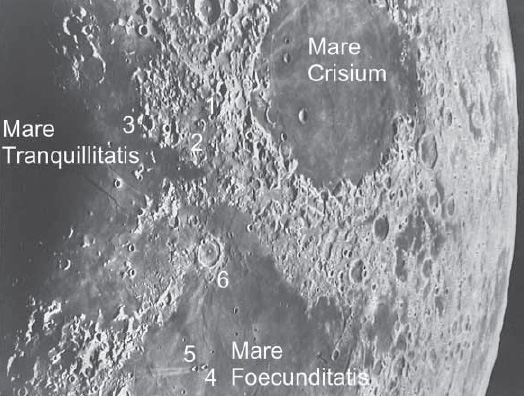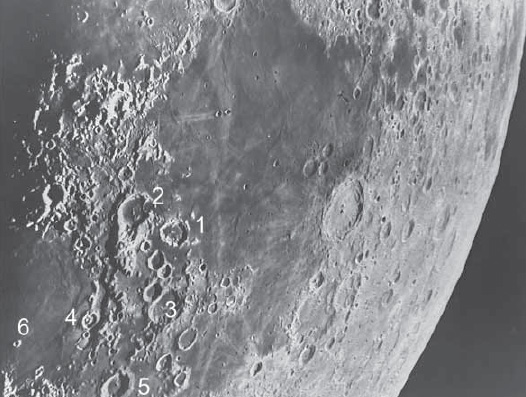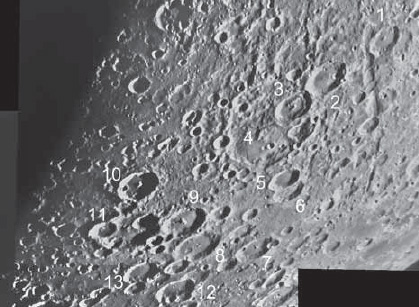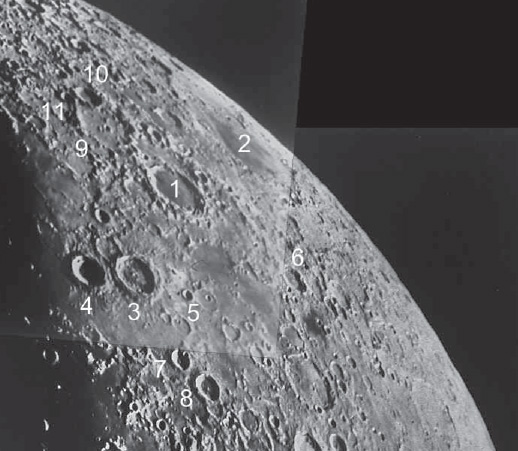Following the Terminator Part 2
By Joseph Cohen
First published Crux Jun-Jul 2007
Introduction
Day 4-5
Before studying the terrain exposed by the terminator, review the areas previously discussed. Higher power views will often give information not presented in this article but are there for the observer to discover for him/ herself. Some craters that appeared as sunlit ramparts and whose floors were dark holes are beginning to show their structures. Other structures are losing their prominence while some now appear, due to changes in the angle of illumination. This scenario will continue as we follow the terminator. (Note: The images of the Moon in this article show a direct view for an observer in the northern hemisphere and are thus rotated 180 degrees in comparison to the direct view for an observer in the southern hemisphere.)
Southern Hemisphere
The terminator has moved past M. Crisium and will appear to move faster as it leaves the side of the globe. The cusps appear fuller, especially near the southern pole. As the highlands west of M. Crisium are uncovered, PROCLUS (Fig. 1, 1) a small crater sitting at the edge of the cliff overlooking PALUS SOMNII (Fig. 1, 2) will develop a north and south ray at a 160 degree angle that will later spread like a fan over the highland west of M. Crisium.

Figure 1 :
Central region of the Moon, Day 4-5
1 Proclus 2 Palus Somnii 3 Lyell 4 Messier 5 W Pickering 6 Taruntius
Image from the Consolidated Lunar Atlas maintained by the Lunar and Planetary Institute.
The crater and its surrounds will later become one of the brighter areas and should be observed for many nights. At the west tip of the Palus, LYELL (Fig. 1, 3) overlooks M. TRANQUILLITATIS. M. FOECUNDITATIS has been fully exposed and two small craterlets MESSIER (Fig. 1, 4) and its western companion W. PICKERING (Fig. 1, 5) lie in its floor. Later, from W. Pickering two almost parallel rays pass westwards to the lesser peninsula. Extending this line to the west will cross a number of small craterlets that may be associated with the rays.
By the fourth day TARUNTIUS (Fig. 1, 6), on guard between the sea and M. Tranquillitatis, that earlier had its ramparts standing out in the darkness, will soon show its structure and central mountain. A line from Langrenus extending westward will cross several interesting craters that are a useful guide to nearby structures. First, GOCLENIUS (Fig. 2, 1) at the east side of the peninsula is seen as a round crater with a bright rim and dark floor representing the eye of the lady of the moon who is either reading a book or looking in a mirror that is M. NECTARIS.

Figure 2 :
Mare Nectaris and the Pyrenees, Day 4-5
1 Goclenius 2 Gutenburg 3 Colombo 4 Bohnenberger 5 Santbech 6 Rosse
Image from the Consolidated Lunar Atlas maintained by the Lunar and Planetary Institute.
South of Goclenius a group of small craters lead to COLOMBO (Fig. 2, 3), a large irregular crater with an offcentred mountain, whilst west of Goclenius GUTENBERG (Fig. 2, 2), a damaged pear shaped structure due to its communication with a smaller southern crater, forms the nose of the lady and points south to the PYRENEES mountains running parallel to the almost straight east coast of M. Nectaris. At early lighting the range casts a shadow over the coastal lowlands where BOHNENBERGER (Fig. 2, 4) with its central mountain is easily identifi ed by the small craterlets to its north and south. At the base of the peninsula, SANTBECH (Fig. 2, 5), a deep crater with a central mountain has a small craterlet in its floor and a gutter in its north wall. M. NECTARIS is a depressed sea and is mostly in darkness, but the rim of FRACASTORIUS appears as a horseshoe at its south shore, whilst the west rim of BEAUMONT and THEOPHILUS also catch the early morning sunrays. In the floor of the sea ROSSE (Fig. 2, 6) to the southeast and MÄDLER at the junction to M. Tranquillitatis stand out from the darkened floor, and a bright white line from Mädler’s east wall passes east to a small bright spot and may be seen a little later. A ridge can also be seen on the west floor of the sea passing from Beaumont to Theophilus. At the north coast of the sea are dissimilar twins right next to each other. CAPELLA with a central mountain is gutted at its north and south walls and invades ISADORUS that has a small craterlet at its west wall. At the north west corner of the lesser peninsula CENSORINUS, a small crater, will later become one of the moon’s bright spots. South of Fracastorius, PICCOLOMINI with its terraced walls and central mountain is a well formed crater that is only partly lit, as is the south portion of the ALTAI scarp. Later, the Altai scarp will be seen passing to the north and is concentric to M Nectaris. At some lightings it appears to become continuous with the coast of a small bay north of Theophilus. The south portion of the Altai scarp points across Piccolomini to RHEITA (Fig. 3, 1) and its valley one M. Nectaris diameter away. The valley consists of a series of small communicating craters with Rheita lying east of their north end. A south meridian line from Rheita crosses METIUS (Fig. 3, 2) that has several small mountains towards its north floor.

Figure 3 :
Southern Cusp of the Moon, Day 4-5
1 Rheita 2 Metius 3 Fabricius 4 Janssen 5 Steinheil 6 Watt 7 Biela 8 Rosenberger 9 Vlacq 10 Pitiscus 11 Hommel 12 Hagecius 13 Nearch
Images from the Consolidated Lunar Atlas maintained by the Lunar and Planetary Institute.
Metius abuts onto FABRICIUS (Fig. 3, 3), a crater with a small central mountain and a ridge on its west floor. This crater intrudes deeply into JANSSEN (Fig. 3, 4), a large damaged crater and the four craters lie on the same meridian and point to a group further south. Near Janssen’s south east edge, a fi gure of eight structure made by two small craters WATT (Fig. 3, 6) and STEINHEIL (Fig. 3, 5) is a useful guide to the area. Further south we meet BIELA (Fig. 3, 7) with a small central mountain and a small crater at its south wall with a smaller one on its north wall. This crater begins a group of four craters on an arc convex to the south. Biela is slightly separated from ROSENBERGER (Fig. 3, 8) that has a central mountain and a small crater at its south end. The latter touches the west VLACQ (Fig. 3, 9) that has a larger central mountain and a larger space separates it from the western PITISCUS (Fig. 3, 10) with two craterlets in its floor, the north one partly destroying a short mountain range and may be only partly lit at the early portion of this period. Note the increase in the apparent obliquity of the four craters as they approach the limb. South of the two, HOMMEL (Fig. 3, 11) a larger crater touches Vlacq and has two obvious craters at its north west wall and a smaller one at its south east wall. Just south of the group, HAGECIUS (Fig. 3, 12) a footlike crater has several craterlets at its south end like a series of toes and at its north end a larger craterlet forming its heel. To its west NEARCH (Fig. 3, 13), a double crater looks like a misshapen eight, the communicating wall between it and NEARCH A, the smaller southern crater being destroyed. The areas closer to the South Pole are best viewed later.
Northern Hemisphere
Turning to the east extension of the northern continent, ENDYMION (Fig. 4, 1), a large walled plain lies halfway between M. Crisium and the North Pole.

Figure 4:
Northern Cusp of the Moon, Day 4-5
1 Endymion 2 M. Humboldtianum 3 Atlas 4 Hercules 5 Chevallier 6 Mercurius 7 Cepheus 8 Franklin 9 De La Rue 11 Thales 10 Strabo
Images from the Consolidated Lunar Atlas maintained by the Lunar and Planetary Institute.
Its dark floor is becoming more apparent and the plain lies opposite the dark M. HUMBOLDTIANUM (Fig. 4, 2) at the lunar edge. This sea may project its floor against the sky at some lunations. Slightly south and west the twins ATLAS (Fig. 4, 3) and HERCULES (Fig. 4, 4) at the east coast of LACUS MORTIS are becoming illuminated and should be followed throughout the month. Their appearances change depending on libration and angle of illumination. Atlas will appear as a dark black hole with sunlit ramparts. By the time its floor is partly illuminated to show several small mountains in its floor, the west wall of Hercules will be illuminated and its floor in darkness, but by the end of the fi fth day the floor’s structures can be seen. Atlas develops a south dark spot and later a dark north spot, whilst Hercules presents an obvious craterlet in its south floor. A line through both craters passing eastwards crosses two small narrow looking craters, MERCURIUS (Fig. 4, 6) and ZENO at the limb. The same line will be used later to fi nd some west craters. A little east of Atlas and north of a small crater CHEVALLIER (Fig. 4, 5) a bright spot appears to be a small mountain or dome lit from the east. South of Atlas and on the same meridian, CEPHEUS (Fig. 4, 7) with a craterlet on its east wall and the larger south FRANKLIN (Fig. 4, 8) with a larger central mountain lie inland from LACUS SOMNIORUM. Near Endymion but closer to the North Pole the large DE LA RUE (Fig. 4, 9) is showing its floor and its two companions: STRABO (Fig. 4, 10) and THALES (Fig. 4, 11) its west companion, at its polar end.